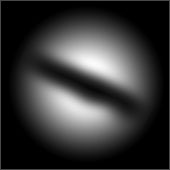What are we looking at here? In 1774, amateur-astronomer-turned-pro Johann Bode discovered two nebulous objects close together near the Big Dipper. He had no idea what they were. But neither did anyone else, so Bode added them to his catalog of nebulous objects and carried on. Charles Messier read about them and added them to his own catalog as M81 and M82.
Eventually, M81 (many still call it "Bode's Galaxy") was revealed to be a giant spiral galaxy near our own Milky Way. M82 was also identified as a galaxy, but many mysteries remained. In particular, why did it look like it was exploding? In 1963, astronomers took high-resultion images of M82 and determined that the gaseous filaments seen in the photo were flying out of the center of M82 at more then 500 kilometers per second.
At first astronomers suspected M82 had a violent nucleus, like those seen in quasars and active galaxies like M77. Instead, it turned out Bode's other discovery was to blame: Its big brother, M81, was causing M82 to act up.
Millions of years ago, M81 and M82 flew past each other in their long, lazy orbits. The larger galaxy, M81, rattled the smaller one as it flew past, like a speeding truck disturbing a puddle on the side of the road. Density waves sloshed inside of M82 and compressed gas near its core. The gas condensed and created thousands and thousands of new stars—a stellar baby boom. Millions of years later, those stars began to reach the end of their life, and just as they were born together, they died together. Thousands of supernovas exploded in a (relatively) brief period of time, and the collective blast from all those explosions streamed out of the core.
Unravelling the nature of M82 took almost two centuries and required dozens of independent insights from many astronomers. But Johann Bode, the one who first spotted those two faint patches of light and wrote them down in his journal, is the only name commonly associated with M81 and M82. Those other astronomers? I confess I don't even know their names.
Imaging Notes
Even with modest equipment a beginner can capture a decent picture of M82 showing its cigar shape and the turbulence at its core. Showing the faint streams of supernova wind is harder, but well worth the effort.
As with any galaxy, the longer you expose, the better. Think hours instead of minutes. The luminance frame for the image above consists of stacked one-minute exposures totalling three hours. The color data adds another three hours of exposures.
 Processing the image is also tricky because the faint tendrils of gas are much fainter than the core of the galaxy. I used a circular mask with the bright center of the galaxy cut out in order to brighten the ejected gas without overexposing the core (see image at right). You can create this mask by starting with a radial gradient and subtracting the brightest areas of the galaxy.
Processing the image is also tricky because the faint tendrils of gas are much fainter than the core of the galaxy. I used a circular mask with the bright center of the galaxy cut out in order to brighten the ejected gas without overexposing the core (see image at right). You can create this mask by starting with a radial gradient and subtracting the brightest areas of the galaxy.
Another way to accentuate the faint supernove wind is to use an Hα filter.The Hα filter only transmits light from ionized hydrogen, which is what the supernova wind is composed of. Mix Hα exposures into the red channel for the most natural look.
For color balance remember that the main body of the galaxy is a ghostly blue while the streams shooting out of the core are red.
M81 & M82
A very common shot is to capture both M81 and M82 in the same frame. They are separated by 38 arcminutes; a frame one-degree across can fit them both in.

